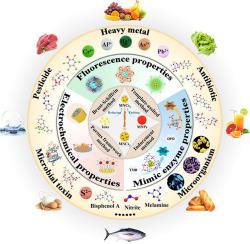Coordination Chemistry Reviews ( IF 20.3 ) Pub Date : 2022-12-20 , DOI: 10.1016/j.ccr.2022.214964 Yi Pan , Zi Han , Shouhui Chen , Kang Wei , Xinlin Wei

|
近年来,食品安全问题频发,给人们的生命健康带来极大威胁。因此,迫切需要开发有效的传感方法来检测食品基质中的污染物。通过将食品检测与功能纳米材料相结合,可以开发出有效的食品安全监测技术。如今,金属纳米团簇 (MNCs) 被认为是非常有前途的纳米材料,因为它们具有明显优于金属纳米粒子的性能。优异的光学性能、电学性能和催化能力拓宽了MNCs在开发新型传感器方面的应用前景。本综述全面介绍了跨国公司的主要合成策略,并总结了过去十年中它们在构建敏感和特异性传感策略以分析食品底物中的各种污染物方面的应用。此外,详细讨论了MNCs的荧光、电化学(包括电化学催化和电化学发光)和模拟酶特性在食品安全监测中的潜在应用,并通过典型的传感应用实例详细阐明了它们的传感机制。综述总结了基于MNCs的传感器的应用挑战和发展趋势。我们希望这篇综述能为根据 MNCs 在传感领域的独特特性设计基于 MNCs 的传感器提供有价值的想法。详细讨论了MNCs的荧光、电化学(包括电化学催化和电化学发光)和模拟酶特性在食品安全监测中的潜在应用,并通过典型的传感应用实例详细阐明了它们的传感机制。综述总结了基于MNCs的传感器的应用挑战和发展趋势。我们希望这篇综述能为根据 MNCs 在传感领域的独特特性设计基于 MNCs 的传感器提供有价值的想法。详细讨论了MNCs的荧光、电化学(包括电化学催化和电化学发光)和模拟酶特性在食品安全监测中的潜在应用,并通过典型的传感应用实例详细阐明了它们的传感机制。综述总结了基于MNCs的传感器的应用挑战和发展趋势。我们希望这篇综述能为根据 MNCs 在传感领域的独特特性设计基于 MNCs 的传感器提供有价值的想法。并通过典型的传感应用实例详细阐明了它们的传感机制。综述总结了基于MNCs的传感器的应用挑战和发展趋势。我们希望这篇综述能为根据 MNCs 在传感领域的独特特性设计基于 MNCs 的传感器提供有价值的想法。并通过典型的传感应用实例详细阐明了它们的传感机制。综述总结了基于MNCs的传感器的应用挑战和发展趋势。我们希望这篇综述能为根据 MNCs 在传感领域的独特特性设计基于 MNCs 的传感器提供有价值的想法。

"点击查看英文标题和摘要"































 京公网安备 11010802027423号
京公网安备 11010802027423号